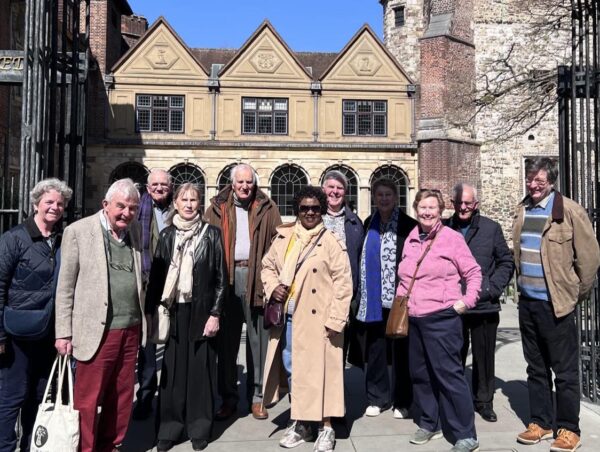Several Rotarians and their guests recently enjoyed an enlightening visit to the Charterhouse Museum and Chapel – a hidden gem tucked away near London’s Barbican.

Although the day began under grey skies, the sun made a welcome appearance just in time for the group’s arrival at Charterhouse – an historic complex steeped in centuries of remarkable stories. As our group gathered at the gate, we took in the pretty surroundings and nearby architectural landmarks, including Florin Court, a striking 1930s Art Deco building familiar to fans of Agatha Christie’s Poirot.
Our tour of the site was led by “Brother” Raymond, a Charterhouse resident of five years and a charming, knowledgeable guide. As one of the Brothers living in this unique almshouse community, he offered an insider’s view of both the history and the present life of Charterhouse.
The site, long associated with learning and care, was once a Carthusian monastery, later a Tudor mansion, then a public school and, since 2017, a museum and living community. Despite the name, there are no monks there now.
Brother Raymond guided us through the peaceful, immaculate gardens and explained the origins of the site, which dates back to 1348 when it served as a mass burial ground during the plague. Work on the Elizabeth tube line uncovered moving evidence of plague victims – including a mother and child buried holding hands. Standing by the gate we all looked at the original monastery layout etched into the pavement.
We learned about Sir Walter de Manny, who initially leased land for the burial ground that now forms Charterhouse Square. Later, he founded the Carthusian monastery on adjacent land in 1371. We learned that he was buried before the altar – his identity was confirmed centuries later by a seal found on his chest.
One of the stories Raymond told us about the site’s history was rather grim – the brutal execution and quartering of monks who resisted signing the Act of Supremacy under Henry VIII. A plaque commemorates their martyrdom.
The Charterhouse name itself comes from the Carthusian monks who travelled from the Chartreuse mountains in France. Known for their strict vows of silence and solitude, these monks lived in small, self-contained cells, emerging only one day a week for exercise and conversation. Interestingly, lay brothers (in blue) had more freedom of movement than the cloistered white-robed monks.
The site has seen many transformations. During the reign of Elizabeth I, the property was purchased by Edward North – who refurbished it extensively and occasionally hosted the Queen and her large entourage.
In the 17th century, the site was acquired by Thomas Sutton, one of London’s earliest moneylenders and a philanthropist. In 1611, he established an almshouse and school there, supporting elderly ex-servicemen – or “Brothers” – who still reside on the premises today.
Women were finally welcomed as Brothers in 2017, though the name remains unchanged.
The Great Hall, now used for events, has witnessed everything from royal banquets to fashion shows (including one by Alexander McQueen). The panelled walls and ornate ceiling are largely reproductions, with some areas fire-damaged and later restored. In the adjacent Great Chamber – once used by Elizabeth I – we admired the intricate décor, green silk wall coverings, and oil portraits of historic governors. We also learned that an Italian artist under house arrest was responsible for the room’s rather elaborate ceiling.
In the cloisters and chapel, we discovered more about the community’s layered past, We viewed carved coats of arms and noticed dogs depicted throughout the building – a symbol of loyalty.
During the visit we were impressed by the scale of the place and its rich history. It seemed strange that such a peaceful place could be found so close to the hustle and bustle of London’s Barbican.
Today, the Charterhouse remains a place of community. Prospective Brothers must be over 60, of limited means, in good health, and willing to embrace communal living. Meals are shared in the Great Hall, with breakfast, lunch, tea, and dinner provided. Life there is not just about comfort – but about belonging.
Our visit was informative, deeply moving in places, and peppered with surprising anecdotes – including the time Brother Raymond looked out to see a unicorn beneath his window. It had, of course, appeared for filming of Game of Thrones!
We concluded our outing with a visit to the Museum shop and left Charterhouse with a new appreciation for this fascinating slice of London’s history.
Picture: A photo of most of the Rotarians and guests outside Charterhouse.. Picture credit: Rotary Club of Canterbury.
(Further pictures will be available soon on our Facebook page.)


